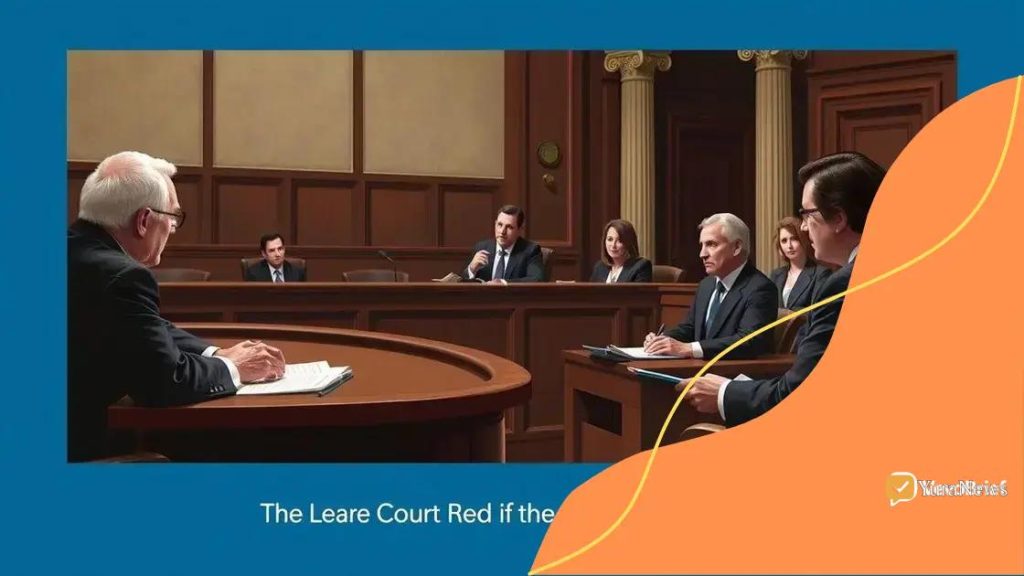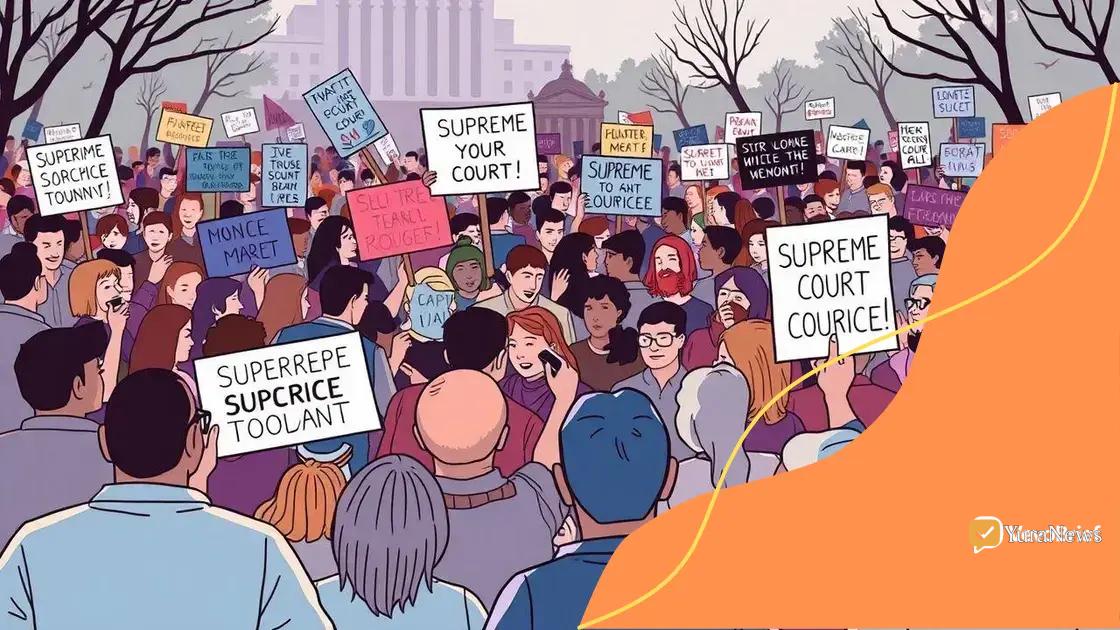Controversial Supreme Court rulings shaping America

Anúncios
Controversial Supreme Court rulings significantly influence American law and society by shaping rights, reflecting evolving values, and prompting public engagement in discussions about justice and equality.
Controversial Supreme Court rulings continue to spark debate and shape the legal landscape of America. These decisions not only reflect societal values but also challenge established norms, making them crucial to understand. What are the most significant rulings, and how have they influenced our daily lives?
Anúncios
Historical context of controversial rulings
Understanding the historical context of controversial rulings is essential for grasping their significance today. These decisions often reflect the values and conflicts of their times.
The Supreme Court has played a vital role in shaping American law, addressing issues from civil rights to free speech. Each ruling not only resolves specific cases but also sets precedents that influence future cases.
The Evolution of Judicial Review
The process of judicial review began with the landmark case of Marbury v. Madison in 1803. This case established the principle that the Supreme Court could overrule both Congress and the President, solidifying its power in interpreting the Constitution.
Anúncios
Key Historical Moments
Several key moments in U.S. history marked the Supreme Court’s involvement in controversial rulings:
- Brown v. Board of Education (1954) – A crucial ruling that declared racial segregation in public schools unconstitutional.
- Roe v. Wade (1973) – A landmark decision that recognized a woman’s legal right to have an abortion.
- Obergefell v. Hodges (2015) – This ruling legalized same-sex marriage across the United States.
These cases illustrate how the Court’s decisions can reflect societal shifts and challenge existing norms. As society evolves, so do the interpretations of the Constitution, leading to rulings that often stir public debate.
Analyzing the historical context helps shed light on why these rulings are viewed as controversial. They often highlight deep societal divides, making their implications far-reaching and complex.
The ongoing dialogue about these decisions demonstrates the dynamic nature of American law and the continual influence of the Supreme Court on the rights and liberties of citizens.
Landmark decisions and their significance
Exploring landmark decisions in the Supreme Court reveals their profound impact on American society. These cases not only set legal precedents but also often reflect the evolving values and priorities of the nation.
One significant decision is Marbury v. Madison, which established the principle of judicial review. This case affirmed the power of the Court to invalidate laws that contradict the Constitution, laying the groundwork for future rulings.
The Impact of Brown v. Board of Education
An essential ruling, Brown v. Board of Education (1954), overturned the precedent established by Plessy v. Ferguson. This landmark case declared racial segregation in public schools unconstitutional. Its significance extends beyond education, as it played a vital role in the Civil Rights Movement.
Civil Rights and Equality
The Supreme Court has made numerous decisions regarding civil rights. In addition to Brown, Roe v. Wade (1973) recognized a woman’s legal right to abortion. This case remains one of the most debated rulings and highlights ongoing discussions about women’s rights.
- Obergefell v. Hodges (2015) legalized same-sex marriage, affirming the rights of LGBTQ+ individuals.
- United States v. Nixon (1974) held that no person, not even the president, is above the law, reinforcing governmental accountability.
- Citizens United v. FEC (2010) allowed for increased political spending, raising questions about the influence of money in politics.
These landmark decisions illustrate how the Court has influenced key aspects of rights and freedoms in America. Each ruling holds significance, affecting generations and shaping public discourse.
The consequences of these cases often spark debates that resonate within communities, highlighting the need for ongoing discussions surrounding justice and equality. As policies continue to evolve, the significance of landmark rulings remains as relevant as ever, prompting individuals to reflect on their nation’s values and direction.
Public reactions and societal impacts

Public reactions to Supreme Court rulings often shape the social landscape. Each decision sparks discussions that ripple through communities, impacting lives in unexpected ways.
Following major cases, reactions can be mixed, reflecting a wide range of perspectives. For instance, after the ruling in Roe v. Wade, people celebrated and protested, showcasing the deep divisions on issues of reproductive rights.
Examples of Public Response
Significant rulings can lead to widespread activism. The decision of Obergefell v. Hodges, which legalized same-sex marriage, prompted celebrations across the United States. Pride events grew, highlighting advancements in LGBTQ+ rights.
The Role of Social Media
In today’s digital age, social media plays a crucial role in shaping public opinion. Debates over rulings are often amplified online, where people share their views, organize protests, and mobilize supporters.
- Post decisions, hashtags trend on platforms like Twitter.
- Online petitions gain traction, influencing future legislation.
- Websites and forums provide spaces for discussion and dissent.
The ability to voice opinions online allows for a quick response to Court decisions, leading to immediate societal impacts. This dynamic enhances engagement in civic matters and keeps critical issues in the public eye.
Public demonstrations, like marches and rallies, often emerge following pivotal rulings. These events serve as expressions of solidarity and demand for justice. Each turnout reflects a community’s commitment to advocating for their beliefs.
Through these reactions, society continually reflects on values and priorities. Each ruling highlights the ongoing struggle for rights and freedoms, shaping the collective consciousness of the nation. As these conversations evolve, the implications of Supreme Court decisions linger, influencing future generations.
The role of dissenting opinions
The role of dissenting opinions in Supreme Court rulings is crucial for understanding the breadth of legal thought. These opinions allow justices to express differing views, often highlighting significant aspects of the case that may not be reflected in the majority opinion.
Dissenting opinions can bring attention to minority perspectives, stirring public conversation. They often serve as a voice for those who disagree with the prevailing legal reasoning. An example is Justice Ruth Bader Ginsburg’s dissent in Bush v. Gore (2000), where she articulated concerns about voting rights and the electoral process.
Impact on Future Cases
Dissents can influence future legal battles, creating a roadmap for challenges. A powerful dissent today might inspire tomorrow’s legal arguments or shape public opinion. Over time, some dissenting viewpoints become mainstream, illustrating the evolving nature of the law.
Examples of Influential Dissents
Notable dissents have had lasting impacts:
- Justice Oliver Wendell Holmes in Abrams v. United States (1919) defended free speech, arguing that the best test of truth is the power of the thought to be accepted in the marketplace of ideas.
- Justice John Marshall Harlan in Plessy v. Ferguson (1896) strongly dissented against racial segregation, stating, “Our constitution is color-blind, and neither knows nor tolerates classes among citizens.”
- Justice Ginsburg in Whole Woman’s Health v. Hellerstedt (2016) highlighted that laws imposing restrictions on abortion clinics did not improve women’s health.
The articulation of dissenting views can lead to greater discourse and understanding in the legal landscape. They often resonate beyond the courtroom, sparking activism and public debate.
In summary, dissenting opinions contribute significantly to the legal process. They remind society that the law is not static but rather a reflection of ongoing discussions about justice and rights.
Future implications for American law
The future implications for American law following Supreme Court decisions can be profound. Each ruling shapes not only current laws but also influences legal interpretations for generations to come.
As society evolves, the law must adapt to reflect changing values. Decisions made today can either advance rights or create new challenges for individuals. For instance, the ruling in Obergefell v. Hodges (2015) has paved the way for greater acceptance of LGBTQ+ rights, changing the legal landscape significantly.
The Influence of Precedent
Precedent plays a crucial role in American law. Rulings set legal standards that future cases are expected to follow. This ensures consistency and predictability in the legal system. However, it also means that controversial decisions can lead to long-lasting effects.
Emerging Legal Challenges
With each decision, new challenges arise. Legal experts and advocates closely monitor how these rulings will affect various aspects of American life. Key areas impacted include:
- Reproductive rights and access to healthcare.
- Voting rights and election laws.
- Freedom of speech and expression.
- Equality in the workplace and education.
As societal views shift, there may be calls for new legislation or amendments to existing laws. This creates a dynamic landscape where public opinion and legal decisions often intersect.
Public discourse around these implications is crucial. Citizens and policymakers must engage in discussions about how laws evolve and what that means for civil liberties. Advocacy groups play an essential role in ensuring that diverse voices are heard in these debates.
Understanding the future implications of Supreme Court rulings helps promote an informed citizenry. An educated public can better advocate for changes that align with their values and vision for society. As America looks toward the future, the law will continue to be a reflection of the ongoing struggle for justice and equality.
In conclusion, Supreme Court rulings have a powerful impact on American society and law. These decisions shape our rights, influence public opinion, and reflect the values of our changing world. By understanding both the implications and the dissenting opinions, we can engage more meaningfully in conversations about justice and equality. As we look to the future, citizens must remain informed and active in advocacy to ensure that our legal system continues to progress toward fairness for all.
\n
\n
FAQ – Frequently Asked Questions about Controversial Supreme Court Rulings
What role do Supreme Court rulings play in American society?
Supreme Court rulings shape civil rights, influence public opinions, and set legal standards that affect everyone.
How do dissenting opinions impact future court cases?
Dissenting opinions provide alternative viewpoints that can inspire future legal arguments and reforms.
Why is public engagement important after a Supreme Court ruling?
Public engagement helps ensure that diverse voices are heard in discussions about justice and rights after a decision is made.
How can citizens influence future legal changes?
Citizens can influence legal changes by staying informed, advocating for their beliefs, and participating in discussions and activism.